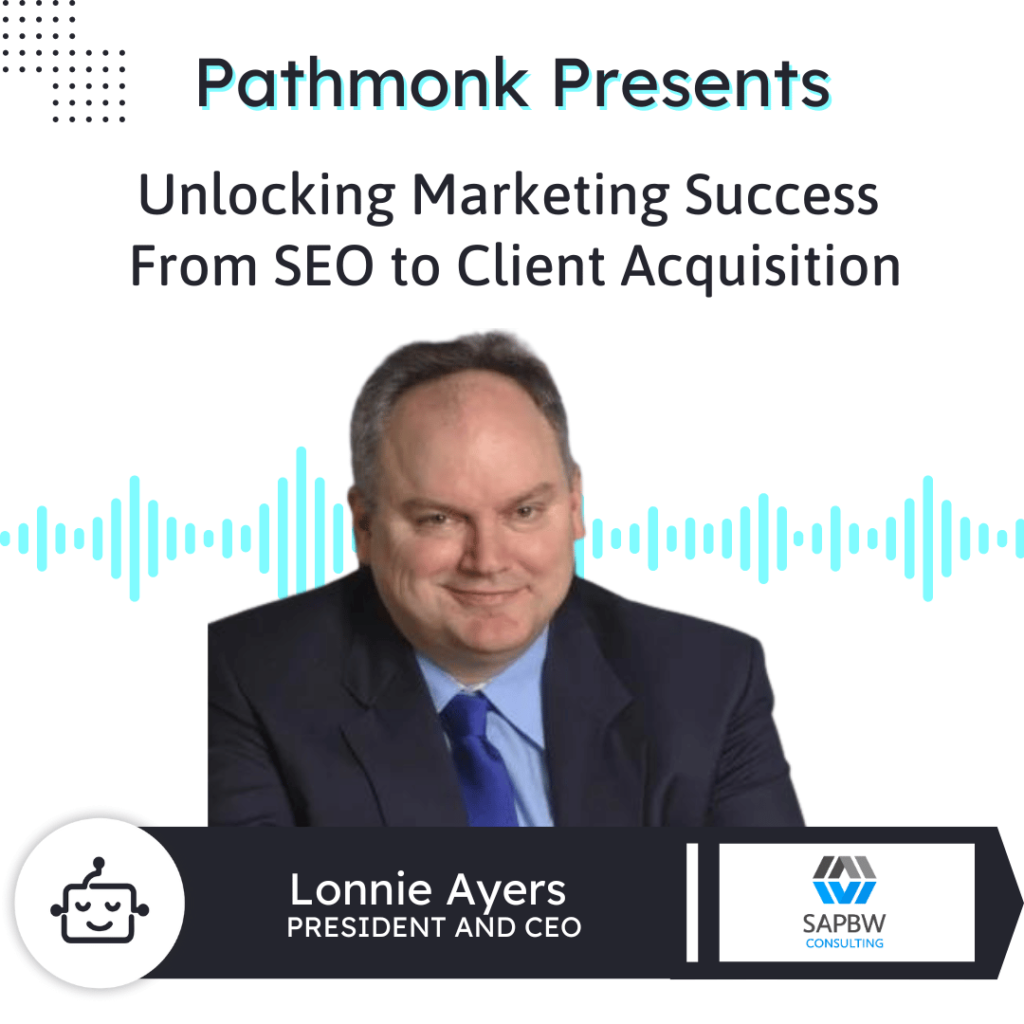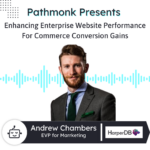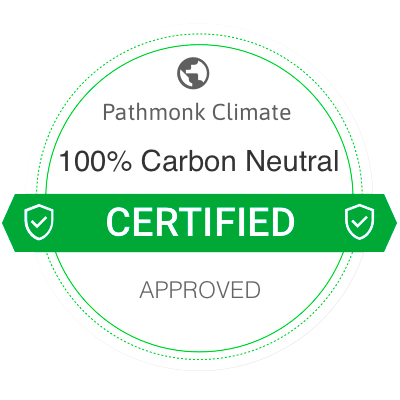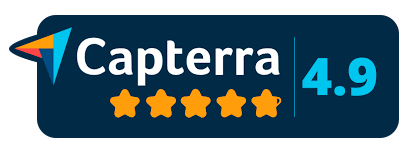
Introduction
Join us on Pathmonk Presents as we delve into the dynamic world of digital marketing with Lonnie Ayers, President and CEO of SAP BW Consulting, Inc.
In this episode, Lonnie shares his wealth of experience in inbound marketing, lead generation, and client acquisition. Discover how SAP BW Consulting leverages SAP BW and SAP BusinessObjects tools, alongside HubSpot’s CRM system, to drive remarkable business growth for SAP Partners and customers. With insights into diverse industries and high-impact strategies, Lonnie reveals the secrets behind successful marketing funnels and organic traffic generation.
Tune in for a masterclass on optimizing your marketing efforts and achieving outstanding business results.
More Sales From Your Website With AI
Personalized interactions based on your users' behaviour to get +50% more conversions.

Ernesto Quezada: Welcome to Pathmonk Presents, the place where business owners and marketers share their insights on digital growth. In every episode, we discuss real strategies, why they worked, and also why they didn’t. Get insights from real experience and save yourself a whole lot of time and money. Let’s get to it right now.
Before we get started with today’s episode, let’s have a quick look at what Pathmonk is all about. If you are winning leads, demos, or sales through your website, then Pathmonk might be interesting for you. Pathmonk is an extension to your website. It watches each visitor as they’re moving through your page and builds up their interest in your product or service in real time to deliver a great uplift in conversions from your website. Usually, the buying journey can be divided into two stages: awareness, consideration, and decision-making. Pathmonk figures out in which stage a given visitor is by watching every action that they do on the website and provides them with micro-experiences such as notifications, case studies, and introduction videos, helping them to move to the next stage in the buying journey towards a conversion.
Welcome to today’s episode. Let’s talk about today’s guest. We have Lonnie Ayers, President and CEO at SAP BW Consulting. How are you doing today, Lonnie?
Lonnie Ayers: Doing fine. I’m glad to meet you and happy to be here.
Ernesto: It’s great to have you on, someone with your expertise. It’s definitely a privilege to have you on today’s episode. Let’s kick it off. I’m sure listeners are tuning in, wondering what SAP BW Consulting is all about. In your own words, can you tell us a little bit more?
Lonnie: Sure. I’ll give you background on the company and tell you how we got from where we started to where we are today. We’ve been in business about 15 years as an independent, first as an SAP-focused company doing implementations. We’ve used HubSpot for almost that entire time, and we’re now a HubSpot partner, an inbound marketing and sales partner of theirs. We play in the SAP partner space and SAP customer space, both on the SAP side and on the HubSpot side.
Ernesto: Awesome to hear that. So that way our listeners can get a good understanding of your company. What would you say is the key problem that you guys like to solve out there at SAP BW Consulting?
Lonnie: Well, for most companies, first of all, you should know that even though that’s our focus, we get all kinds of different customers from all kinds of different industries. Primarily, it really comes down to they need leads and they need sales. Sometimes they’re very small, and sometimes they’re fairly large and they’ve stumbled. Oftentimes, if they’ve got a machine that was working and now it’s not working, they call us in to fix it. Bottom line, I’ll give an example. About a year ago, we had a school that had gone from really doing well to not doing well at all. When we got into their HubSpot system, we found about 144 issues that had somehow worked their way into the system. We worked through that and turned it back to profitability. We tripled their lead production and quadrupled sales, but it was because things were broken and we put them back together.
Ernesto: Definitely. That’s important, right? As long as you’re going in there and getting it fixed, that’s what everybody’s looking for. You mentioned you work with a couple of industries, but is there a vertical segment? Is there an ideal ICP for you guys?
Lonnie: Yeah. So there are two really. Our target is obviously SAP partners, and it’s because I have a long 25-year history working in SAP itself, where I had a lot of partners I dealt with, and they all universally struggle with how to generate leads. SAP is the beast. For a long time, SAP was simply handing them the leads. They don’t do that anymore unless you’re a great big partner. On the other side, if you’re an SAP customer, oftentimes what we’re running into is they have a HubSpot system, they have an SAP system, and 100 other systems. They’re not as focused. The smaller people, in terms of industry verticals, besides those partners, I personally have an industry background in aerospace and defense. That’s aviation—fixed jets, fly jets, break jets, maintain jets. I’ve got 37 years in that. In my SAP days, my industries included, besides aerospace and defense, travel and transportation, so trucks, trains, planes, ships, professional services—think Accenture and Capgemini of the world—EC&O, which is engineering, construction, and operations. That covers an awful lot of territory, but it’s about how buildings get built. Then postal and government services. Not government, not really where we play that much anymore, but they do a surprising amount of marketing, believe it or not. That’s our core. We can dive in-depth and give them advice relative to their industry because we speak their language. But that said, we haven’t really found anybody that we can’t help. No industry has ever showed up, and I’m like, I don’t know how you do it. What we have is a framework and a methodology that, as long as we’re working within it, the industry is actually just a nice-to-have, but it certainly makes it easier.
Ernesto: Definitely. On that note, you mentioned you work with Chevron, the US Army, and different types of industries out there. How do they usually find out about you? Is there a top client acquisition channel for you guys?
Lonnie: Our number one way, by design, is our website. Today, it’s organic traffic all the way. We don’t do any paid advertising. I do a lot of paid advertising on behalf of clients who want to juice it up, but we have a different model. We’ve produced over the years about 400 things you can download or consume on my website. There’s almost 1,000 blogs, and that’s a very targeted set of content to bring in people. We also get a lot of referrals from happy customers. Those are always great, right? Those are our two big ones. I would say a secondary channel is LinkedIn. We combine those two heavily, and it’s integrated into HubSpot. So we have a nice flow coming right off there, and I’m quite active on LinkedIn.
Ernesto: Definitely. Awesome to hear that. On that note, talking about the website, so that way our listeners can go ahead and visit you guys, you can always check them out at SAPBWConsulting.com. What role does the website play for client acquisition, Lonnie?
Lonnie: It’s educational. In our case, we use it as an educational website. If you’re in the services business like we are, you have two roles: you’re trying to sell your services, and you need to recruit people. Ours is both a client acquisition and recruitment system. Depending on what you do on my website, it actually turns into two different websites and sends you down my marketing funnel or my SAP funnel. It’s a segmentation machine, and most people consume a lot of content off our site. We’ve had, and we keep track of it, some people consume 2,200 pages of our website. That’s kind of the record. We reach out to the guy and ask, what’s out there? He’s just really interested. What it does is it builds trust. Our industry, if anything, is built on trust. We write stuff as professional business consultants. From there, it opens up the doors for us. It’s a lead-gen machine, but it’s a trust-building machine more than anything. Of course, we turn it into sales. That’s our job, ultimately.
Ernesto: Right. Awesome. On that note, you have a lot of expertise. Is there any tools or tips or methods that you would recommend to our listeners as far as website lead generation?
Lonnie: Sure. Our whole thing is on HubSpot, and HubSpot itself is a great platform. There’s, like, the latest partner meeting we had, there’s like 13,000 things that you can plug into it. But I will say that across the years, you’ve got to have a content plan. If you call me today, the first thing I’d be asking you is, what can we build a calculator for? Those are the number one tools. If you can’t calculate it, you probably don’t understand your own business all that much. It goes from—we hardly ever have the little guys—but carpet cleaners to mortgages to houses, the whole thing. If we can build a useful calculator, that will usually be their number one lead-gen tool. That calculator needs traffic, so we will combine that with video, long-form blogs, and a landing page where we collect that video. The other variation they call online tools. In our industry, building a software tool that people can access—there are several on our website. For example, we’ve got a tool that supports this really obscure SAP solution called flexible real estate REFX. You can go in and answer 10 questions, and it will produce a very, very good scoping document that you can turn to a consultant and say, I want to do this. That process used to take a solid three to six months. A guy hired us to do it for him and said, here, you keep it. We have that, and it’s generated, I don’t know, three or four hundred leads over the years. People come in, and the software gets updated, but those questions are pretty universal. That takes a bit of coding, but the challenge is coming up with the idea. There are lots of tools, but once built, they work like a champ.
Ernesto: Awesome to hear that from you. Great tips and methods there. Let’s switch gears a little bit, Lonnie, and talk about you being the President and CEO at SAP BW Consulting. What are some key tasks that you focus on in your day-to-day work?
Lonnie: That routine has developed over the years, but it came out of my life in the military where productivity is kind of the thing. First thing, I get up, I have 25 or 30 client portals that I check. Are there any red lights flashing at me? Make sure they’re running because that’s what pays the bills. Second thing I do is check my calendar. What’s on my calendar for the day, this week? If it’s not on my calendar, it doesn’t happen. My entire site is actually designed to get people to book a meeting with me. When my calendar is full, I’m actually happy. Finally, of course, we all have email, but I’m a big believer and user of rules. I get lots and lots of emails, so I have rules that basically bucket everything and prioritize things into folders. You’ll see that some folders, everything’s always read, and some folders, things are hardly ever read. I have a virtual assistant that I hand off to because there’s gold buried in there. That kind of sets the day. I get it done in a couple of hours in the morning, and the rest of the time is going to be on at work. It’s prioritized dreaming stuff up, what’s the next strategy, working on the business. That’s the routine every day, relentless.
Ernesto: You have a lot of expertise, but with all this content out there, how do you stay up to date? How do you learn, how do you keep on growing? Are there any websites, podcasts, or newsletters?
Lonnie: There are, and I have to say I need to go meet her, but there is one newsletter that I follow religiously. It’s from a lady named Aleyda Solis. She sends out a valuable newsletter once a week. It’s all things SEO, full of links and things that take you to stuff that’s really pretty useful. I can tell she spends a lot of time pulling in the best of the best. As a HubSpot guy, I maintain 13 certifications with them. That means 13 weekends are shot during the year because they expire every year, so you have to retake them. That’s good. But Aleyda’s newsletter is the one that keeps you up to date with all the legal Google scuttlebutt and things like that. It’s probably the top one for me. I listen to podcasts when I’m driving occasionally, but that’s not very often in Spain. In the United States, it’s a different story.
Ernesto: Awesome. Let’s switch to our next section, which is our rapid-fire question round. Are you ready for them?
Lonnie: Sure, go for it.
Ernesto: Awesome. First off, and it can’t be any of yours because you do have a couple of books. You have “How to Dominate Any Market” and “Knowing What to Sell.” It can’t be any of those. What is the last book that you read?
Lonnie: The last book I read is actually about telling short stories. It was called “The Persuasion Story Code” by David Garfinkel. It was so good that I actually used Lumen5 to make a video from his free download. It’s the first customer review I was able to put on Amazon, and he reached out to me on LinkedIn and said thanks. I wasn’t sure I was going to take it, but he did an awesome job. I like the book because it was short, readable, and about how to tell a short story. Over the years, I’ve had people record these calls and tell me, and I couldn’t figure it out. A lady from Chicago said we record these because it’s like taking a class every time. I’m like, dang, I wish I had those recordings. I would do that.
Ernesto: Awesome read. Next up, what is one single thing that your company is focused on the most at the moment?
Lonnie: Well, we’re trying to increase lead generation using artificial intelligence. We’ve just recently been experimenting, not just with ChatGPT, which I do all the time, it’s kind of become part of the job, but we’re using a tool to generate much more content around SAP itself. We’ve been focused on inbound side, and I think it’s because we have enough coming in on that. So we’re going back to our roots and building more long-form, in-depth content, starting with the financial modules and then working our way around what’s called the SAP diamond or 16 core modules in SAP. As it happens, I know quite a bit about all of them, and the machine knows a lot more than me. So that’s really what we’re doing. From an automation standpoint, we actually started off with an automation design 15 years ago because one of my industries was professional services. Almost every process in my business has been automated from the get-go, not just marketing, not just sales, but accounting, payroll, logistics. We knitted that together years ago, and we’re always tinkering with that kind of stuff. Can we simplify it even more? Because I hate doing the admin stuff, but it’s got to be done.
Ernesto: Awesome to hear that. Next one, if there would be no boundaries in technology, what would be that one thing that you want to have fixed for your role as a marketer today?
Lonnie: One of the things that I do is work with a lot of clients on their Amazon product listings and setting up their Amazon stores. They’re real strict, and I wish the AIs that I’m starting to introduce to help me write those product descriptions were much more aware of the Amazon product description guidebooks because if you don’t get it exactly right, you never get it past their screeners. Taking it on my customers that use what’s called variant configuration—different color shoes, different sizes—it gets really complex really quick, and the guidelines cover every aspect of it. It’s still a very manual process. There are tools to help you get it all loaded, but still, if I could automate that and trust it, I’d be a happy camper.
Ernesto: Definitely. Alright, awesome. I think anybody would be a happy camper with that. Next, if there was one repetitive task that you could automate, what would that be?
Lonnie: We’re getting here now, but when I sign up a new customer, the first task I have to do is come up with what’s called an information architecture. I can do a pretty good job with this with ChatGPT, for example, but it still requires a ton of work to research to see if I really have a design here. It’s tedious and takes a lot of effort. You can’t really get… There are two long poles in the tent: one is doing the work and doing the research, which is time-consuming, and the other is getting the client to actually agree to it because there’s no way to measure that to say this is right, this is wrong. I come from an industrial engineering background, where everything is processes and measurements. That part needs to get a lot better. I think we could build better quality, higher converting websites right out of the gate if we could get that part nailed. We’re working on it.
Ernesto: Awesome. Lastly, Lonnie, I definitely want to ask, and I’m really curious. You have a lot of experience already in the marketing world, but what is one piece of advice that you would give yourself if you were to restart your journey as a marketer today?
Lonnie: For the same reason I wrote those books and have six more in the works, know what you’re selling more than anything. Know what you’re selling. I thought I knew what I was selling, and I had sold literally a billion dollars’ worth of software, but that’s just not the case. When I say know what you’re selling, nothing beats getting with a customer and seeing what it is that they think they’re buying from me. I would spend much more of my time and startup budget on that than what I did back then. I probably would have ended up on a different route.
Ernesto: Definitely some great advice there. I think if you’re in marketing, you definitely have to know because if not…
Lonnie: When I say know, I mean know it. This is not new advice. All marketers know you do your ideal customer profile. I’m talking about getting down to it. I’ll give you an example. Before this life, I had about 200 sales engagements in my time at SAP, 235 specifically. They were almost always large scale, where we would maybe spend weeks doing discovery and then doing presales and things like that. We were never solving one problem for a client. That just doesn’t happen that way. We were solving all their problems across all of their functions. Well, what are we selling here? A very complex product with a great big team behind me and all that kind of stuff. As a one or two-man startup, that’s not what you’re selling. You’re selling something completely different. I think you really get that. But I can do both of those. That would be my advice. Every client, by the way, was different in SAP. That’s been the case for the last 100 clients of ours. It’s been a good run. I’ve worked in all kinds of different industries. The knowledge, believe it or not, from aviation applies all across the board for us.
Ernesto: It did, it did. Thank you so much for that. Well, Lonnie, we are coming to the end of the show here, but I do want to give you the last word. If someone forgets everything about the interview today, what is that one thing they should remember about your company?
Lonnie: You need leads. We can get you leads, but we don’t sell leads. We help you generate leads.
Ernesto: There you guys go from Lonnie. Thank you so much, Lonnie, for being with us today. To our listeners, thank you so much for tuning in, and I’m looking forward to our next episode at Pathmonk Presents. Thanks a lot, Lonnie.
Lonnie: You’re welcome. Thanks.











